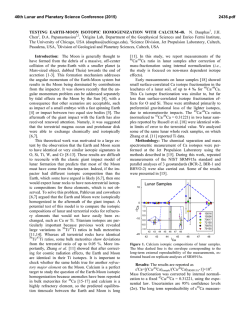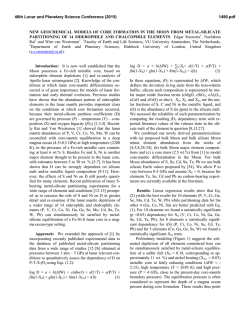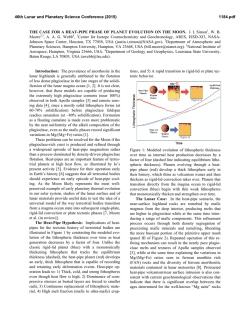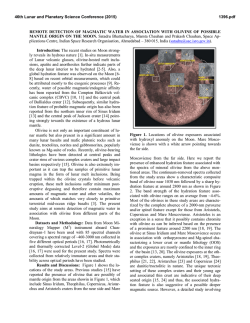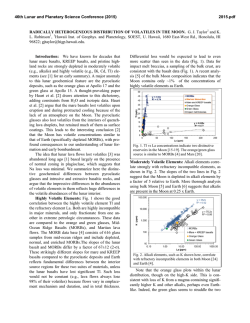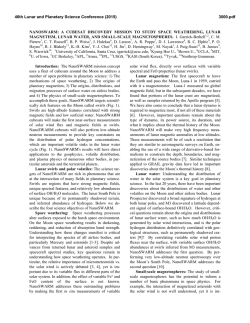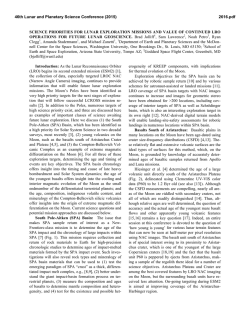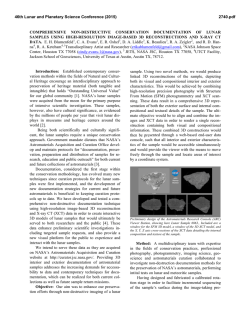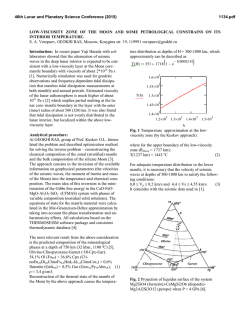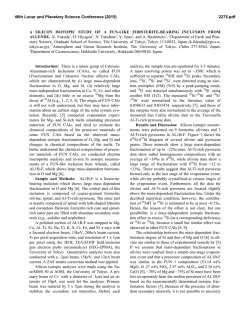
LUNAR DUNITE REVEALS THE SAME IRON ISOTOPIC
46th Lunar and Planetary Science Conference (2015) 1980.pdf LUNAR DUNITE REVEALS THE SAME IRON ISOTOPIC COMPOSITION OF THE BULK SILICATE EARTH AND MOON. Kun Wang1, Stein B. Jacobsen1, Fatemeh Sedaghatpour1, Heng Chen2, and Randy L. Korotev2, 1Department of Earth and Planetary Sciences, Harvard University, 20 Oxford Street, Cambridge, MA 02138, USA ([email protected]), 2Department of Earth and Planetary Sciences, Washington University in St. Louis, One Brookings Drive, St. Louis, MO 63130, USA. Introduction: Isotopic studies have demonstrated that the Earth and Moon are remarkably similar in their isotopic compositions for many elements (e.g., O, Ti, Cr and W isotopic anomalies and Mg and Si stable isotopes). This similarity between the Earth and Moon is unique in our Solar System when compared to other planetary bodies (such as Mars, Vesta 4 and other asteroids represented by the various classes of meteorites). However, in contrast to the isotopic composition of many elements, the Fe isotopic compositions of all lunar samples are significantly different from those of the bulk silicate Earth. This difference is well resolved within the current analytical uncertainties and has been repeatedly reported in samples ranging from mare basalts, highland anorthosites, Mg-suite plutonic rocks, to lunar regolith [1–7]. It has been debated whether such a global Fe isotopic difference represents a primary signature of the Giant Impact due to the evaporative Fe loss [1], or of an unidentified mechanism during magma differentiation on the Moon [2–3, 6]. To better understand the significance of Fe isotopes in the origin of the Moon, we analyzed a variety of lunar materials for Fe isotopes. Sample and Method: In previous studies, no Fe isotopic composition of lunar dunite and other Mgsuite rocks (except of one norite) has been reported. In addition, nearly all the literature data are from analysis of Apollo samples and none from the lunar meteorite collection. Hence, here we analyzed Fe isotopic compositions of additional Apollo lunar samples (dunite 72415, troctolite 76535, basalt 15555), and lunar meteorites (one basalt, two gabbros and five feldspathic breccias). To ensure the reliability of our data, we used two different mass spectrometers for our measurements, a Neptune Plus and an Isoprobe P. The Neptune Plus measurements were done in the medium-resolution mode to resolve molecular interferences while the Isoprobe P measurements were done in the low-resolution mode and relying on a hexapole collision cell to remove molecular interferences. The δ56Fe values ([(56Fe/54Fe)sample/(56Fe/54Fe)standard – 1]×1000) for the standards BHVO-1 and San Carlos olivine show excellent agreement for both instruments. Result: All the lunar data acquired in this and previous studies are shown in Fig.1. Data of lunar meteorites are similar to those from Apollo samples which both continue to display ~+0.1‰ higher than the bulk silicate Earth value [8] and confirm previous studies. However, the most surprising result from this study is that the dunite 72415 shows a significant light Fe isotope enrichment (−0.35 ± 0.02‰). Such negative δ56Fe values have not been observed in any other lunar samples except of one measurement for an orange pyroclastic glass. Fig. 1. Iron isotope compositions of all lunar samples from this study and the literature [1–6]. The dunite 72415 data measured with the Isoprobe P are plotted with red open squares while the Neptune Plus measurements are shown as solid symbols. Discussion: The fact that the lowest δ56Fe value (−0.35‰) among all lunar rocks is observed in the old lunar dunite is very important. Terrestrial peridotites averaging in δ56Fe~0‰, have been argued to define the bulk silicate Earth value [8] and thus the bulk Moon is expected to have this value as shown in many isotopic systems. Light Fe isotope compositions in some terrestrial dunites have also been reported (down to −0.38‰) [9]. These low values have been argued to be the result of the kinetic isotopic fractionation due to high-degree mantle metasomatic activities (exchanging Fe with H2O or CO2 rich-fluids or silicate melts) [10, 11]. The light δ56Fe value of lunar dunite 72415 is unlikely caused by the metasomatism on the Moon as no petrological and mineralogical evidences for such metasomatism have been reported. Alternatively, the light Fe isotope enrichment in dunite 72415 could be explained 46th Lunar and Planetary Science Conference (2015) by the chemical diffusion-driven kinetic disequilibrium fractionation between olivine and melt [12]. However, this mechanism cannot single-handedly create the observed fractionation in dunite 72415 according to the quantitative modeling of the Fe isotopic fractionation during the Fe-Mg inter-diffusion in olivine (contributing up to ~0.21‰) due to 72415 olivine's larger grain size, weaker zoning and lower oxygen fugacity in the Moon relative to the Earth. Also while it is easy to understand how such an effect may apply to olivines in lava lakes; it is not clear that this mechanism would be important in the dunite formation in the Lunar Magma Ocean (LMO). After removing the maximum possible imprint by this effect, dunite 72415 is still significantly different from all other lunar samples and is at least ~0.14‰ lower than the bulk silicate Earth in term of δ56Fe. Therefore, this light Fe isotope enrichment of dunite 72415, likely represents a primary signature of the earliest differentiation event in the LMO. Mg-rich olivines were the first minerals to crystallize and cumulate from the LMO. After 50% crystallization of the LMO, the cumulates are composed primarily of a dunitic composition with ~90% olivine and smaller amounts of orthopyroxene, and/or garnet and spinel [13]. If these dunitic cumulates were enriched in light Fe isotopes as recorded in dunite 72415, the residual melt after this first accumulation, which later formed the anorthosite flotation crust and a leftover KREEPrich intermediate layer, would have been enriched in heavy Fe isotopes. This model is demonstrated with a simple mass-balance calculation in Fig. 2 and Fig. 3 illustrates the model of the Fe isotopic fractionation during dunitic accumulation shortly after the formation of the Moon. Conclusion: We show through high-precision Fe isotopic measurements of one of the oldest lunar rocks (dunite 72415), that the Fe isotopic composition of the bulk silicate Moon is likely identical to that of the bulk silicate Earth, by balancing light Fe in the deep Moon with heavy Fe in the shallow Moon rather than the Moon having a heavier Fe isotope composition than the Earth as a result of Giant Impact vaporization. 1980.pdf Fig. 2. Modeled iron isotope compositions of the cumulates and residual melt after the 50% Lunar Magma Ocean crystallization. The dark grey line on x axis is the measured dunite range and the red line is the range after correction of the maximum diffusion effect (up to ~0.21‰). The histogram (total N=66) on the y axis is all measured lunar samples except of lunar dunite 72415, one orange glass 74220 and all soils. The 50% crystallization model is from literature [13]. Two additional models (20% and 30% crystallization) are also plotted. References: [1] Poitrasson F. et al. (2004) EPSL, 223, 253–266. [2] Liu Y. et al. (2010) GCA, 74, 6249– 6262. [3] Weyer S. et al. (2005) EPSL, 240, 251–264. [4] Wiesli R. A. et al. (2003) EPSL, 216, 457–465. [5] Moynier F. et al. (2006) GCA, 70, 6103–6117. [6] Craddock P. R. et al. (2010) LPS XLI, Abstract #1230. [7] Wang K. et al. (2012) EPSL, 337-338, 17–24. [8] Craddock P. R. et al. (2013) EPSL, 365, 63–76. [9] Williams H. M. et al. (2005) EPSL, 235, 435–452. [10] Poitrasson F. et al. (2013) Contrib. Mineral. Petrol., 165, 1243–1258. [11] Zhao X. et al. (2010) Contrib. Mineral. Petrol., 160, 1–14. [12] Dauphas N. et al. (2010) GCA, 74, 3274–3291. [13] Elardo S. M. et al. (2011) GCA, 75, 3024–3045. Fig. 3. Conceptual model of the Fe isotopic fractionation during dunitic accumulation rapidly after the formation of the Moon. The Modeled values are from Fig. 2 (red line; correction of diffusion effect; 50% crystallization).
© Copyright 2026
